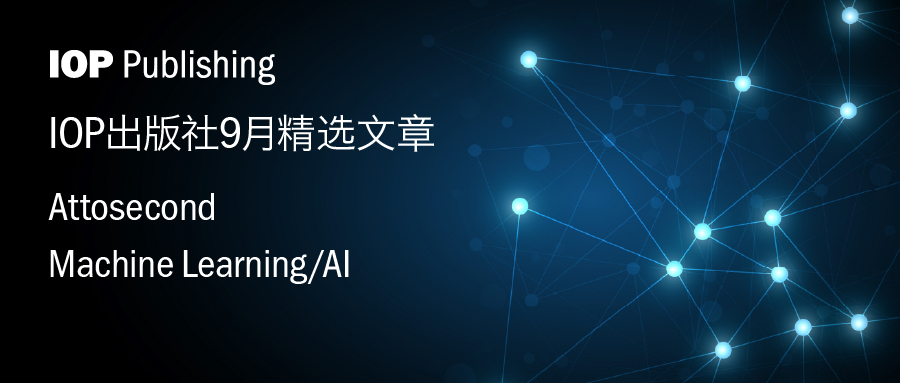IOP出版社9月精选文章——Attosecond&Machine Learning/AI

您可以扫描下方二维码,查看IOP出版社环境、量子和工程领域的最新资讯;还可以点击此处链接,订阅该领域的最新研究进展以及相关期刊的最新信息。


精选文章
Attosecond
JPhys Photonics
Attosecond electron dynamics in solid-state systems
G Inzani and M Lucchini
Absolute delay calibration by analytical fitting of attosecond streaking measurements
G Inzani, N Di Palo, G L Dolso, M Nisoli and M Lucchini
Journal of Optics
Xiaohao Xu, F J Valdivia-Valero and M Nieto-Vesperinas
Dipendra Khatri, Tran-Chau Truong, Chelsea Kincaid, Christopher Lantigua and Michael Chini
Journal of Physics B: Atomic, Molecular and Optical Physics
Jia-Bao Ji and Hans Jakob Wörner
Extreme-ultraviolet field-initiated high-order harmonic generation from molecules
WenZhuo Wu, XuanYang Lai, Wei Quan and XiaoJun Liu
Signature of non-dipole effect in XUV-NIR transient wave-mixing spectroscopy
Yu Zhang, Yueming Zhou, Peixiang Lu and Wei Cao
J B Ji, K Ueda, M Han and H J Wörner
Strong field-induced quantum dynamics in atoms and small molecules
S Eckart
Machine Learning/AI
Journal of Physics D: Applied Physics
Real-time non-invasive quality screening of Yb-doped thin film electrodes using machine learning
Yi-Hsun Chang, Shu-Han Wu, Chih-Hao Lin, Yan-An Chen, Bo-Chang Dong, Cheng-Hao Cheng, Cheng-Han Li, Ming-Yi Lin* and Chun-Ying Huang
JPhys Photonics
Mateo Frausto-Avila, Monserrat Ochoa-Elias, Jose Pablo Manriquez-Amavizca, María del Carmen González-López, Gonzalo Ramírez-García and Mario Alan Quiroz-Juárez
Journal of Optics
Transforming photonics: inverse design for optical cavity engineering
C M Cisowski, R Kilianski and R Bennett
Materials for Quantum Technology
Efficient characterization of blinking quantum emitters from scarce data sets via machine learning
G Landry and C Bradac
Nano Futures
Nanowire design by deep learning for energy efficient photonic technologies
Muhammad Usman
Machine Learning: Science and Technology
Ziyi Zhao, Shishun Zhao, Mingjun Zhou and Yujun Yang
Lin Hu and Guozhu Jia
Miao Cai, Mingyuan Chen, Jiangshan Tang and Keyu Xia
Classical and Quantum Gravity
Lucia Papalini, Federico De Santi, Massimiliano Razzano, Ik Siong Heng and Elena Cuoco
Neural network time-series classifiers for gravitational-wave searches in single-detector periods
A Trovato, E Chassande-Mottin, M Bejger, R Flamary and N Courty
GSpyNetTree: a signal-vs-glitch classifier for gravitational-wave event candidates
Sofía Álvarez-López, Annudesh Liyanage, Julian Ding, Raymond Ng and Jess McIver
Journal of Physics: Complexity
A reinforcement learning-enhanced meta-heuristic framework for network dismantling
Min Wu, Wu Shi, Fengwei Guo, Bitao Dai, Jianhong Mou, Suoyi Tan, Xin Lu and Chaomin Ou
Caroline L Alves, Loriz Francisco Sallum, Francisco Aparecido Rodrigues, Thaise G L de O Toutain, Patrícia Maria de Carvalho Aguiar and Michael Moeckel
Advancing fake news detection with graph neural network and deep learning
Haji Gul, Feras Al-Obeidat, Muhammad Wasim, Adnan Amin and Fernando Moreira
Journal of Physics B: Atomic, Molecular and Optical Physics
A data-driven machine learning approach for electron-molecule ionization cross sections
A L Harris and J Nepomuceno
Specialising neural-network quantum states for the Bose Hubbard model
Michael Y Pei and Stephen R Clark
Machine Learning: Earth
The AI Weather Quest: an international competition for sub-seasonal forecasting with AI
Olga Loegel, Joshua Talib, Frederic Vitart, Jörn Hoffmann and Matthew Chantry
The need of explainability in low-carbon urban system design using AI: A systematic review
Tong Chen and Ramit Debnath
Physics informed neural networks for maritime energy systems and blue economy innovations
Joseph Nyangon
Machine Learning: Health
Mohammad Moulaeifard, Peter H Charlton and Nils Strodthoff
Ethan Eddy, Evan Campbell, Christian Morrell, Heather Williams, Scott Bateman and Erik Scheme
A hybrid deployment model for generative artificial intelligence in hospitals
Maxime Griot, Coralie Hemptinne, Jean Vanderdonckt and Demet Yuksel
Machine Learning: Engineering
Engineering artificial intelligence: framework, challenges, and future direction
Jay Lee, Hanqi Su, Dai-Yan Ji and Takanobu Minami
Daniela F Tellkamp, Nayeon Lee, Gehendra Sharma, Sungkwang Mun, Daniel Johnson and Luke Peterson
Understanding interpretable patterns of Shapley behaviours in materials data
Tommy Liu and Amanda S Barnard
